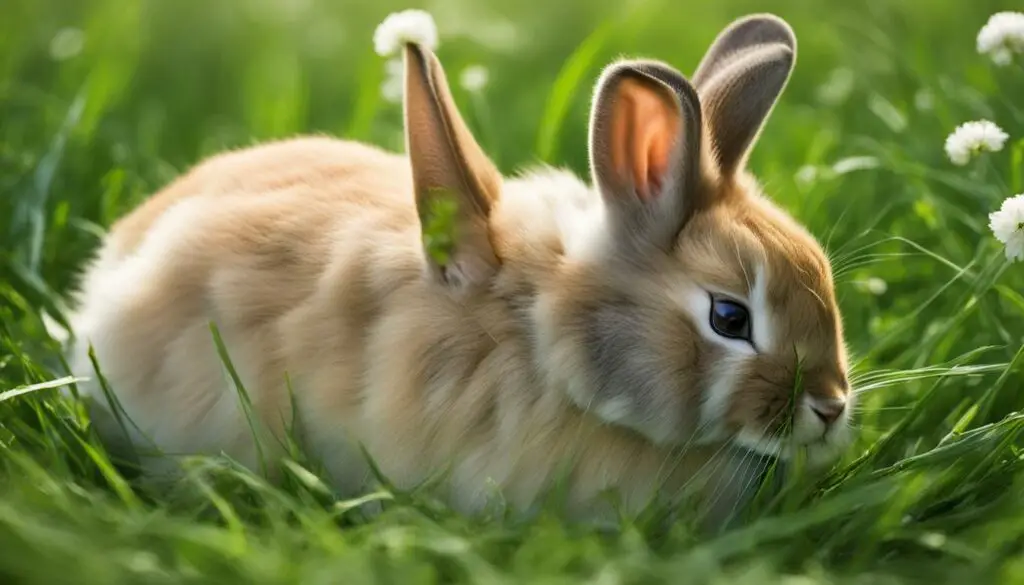Hello, fellow bunny enthusiasts! Today, I want to dive into the fascinating world of rabbit sleep patterns. Have you ever wondered when bunnies sleep and what their sleep habits are like? Well, you’ve come to the right place! In this article, I’ll be shedding light on when bunnies prefer to catch some Z’s and how their unique sleep behaviors contribute to their overall well-being. So, let’s hop right in and explore the intriguing world of bunny slumber!
Key Takeaways:
- Rabbits have unique sleep patterns, often taking short naps throughout the day and night.
- They typically sleep for about 8.5 hours a day, but this can vary depending on their comfort level.
- Rabbits are crepuscular animals, meaning they are most active during the dim light hours of dawn and dusk.
- They can sleep with their eyes open and have various sleep positions.
- A safe and comfortable sleep environment is crucial for rabbits’ overall well-being.
How Much Sleep Do Rabbits Need?
Understanding the sleep patterns and habits of bunnies is essential for providing them with a safe and comfortable environment. So, how much sleep do rabbits actually need? Studies have found that rabbits typically sleep for about eight and a half hours a day on average. However, rabbits that feel safe and comfortable in their home environment may sleep closer to 12 hours a day.
Unlike humans who experience long periods of continuous sleep, rabbits have fragmented sleep patterns. They take short naps interspersed throughout the day, which allows them to quickly snap back to wakefulness, even from deep sleep. This unique sleep pattern makes them alert and ready to respond to any potential threats in their surroundings.
To visually summarize the sleep habits of bunnies, here’s a brief table:
| Hours of Sleep | Sleep Patterns |
|---|---|
| 8.5 hours (average) | Fragmented sleep with short naps |
| 12 hours (in a safe environment) | Fragmented sleep with longer naps |
As you can see, rabbits have unique sleep habits that differ from other animals. Providing them with a safe and comfortable sleep environment, along with a consistent daily routine, will ensure they get the rest they need for optimal health and well-being.
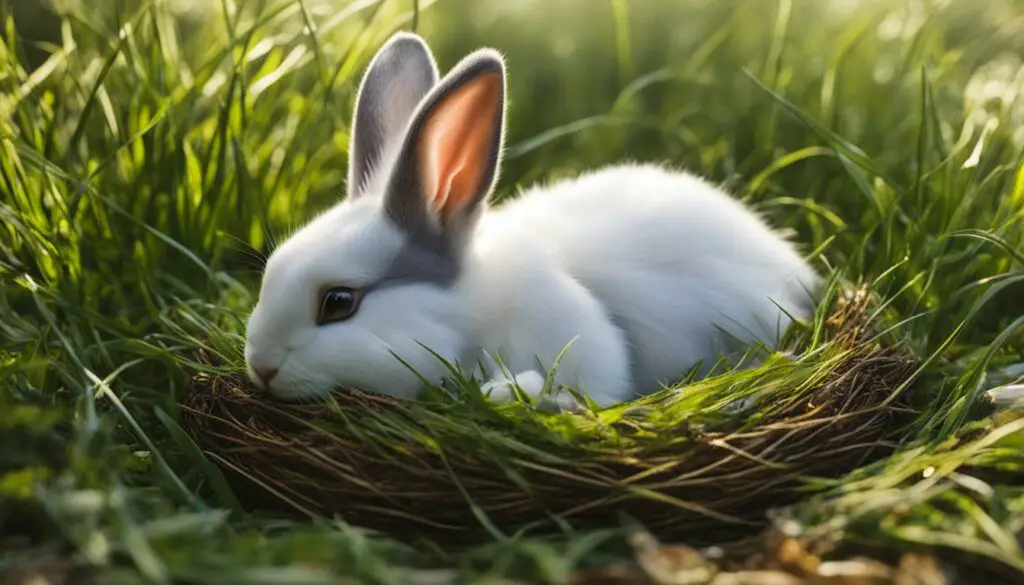
In the next section, we will explore whether rabbits are nocturnal or diurnal creatures and how their sleep patterns differ from other animals.
Are Rabbits Nocturnal or Diurnal?
Rabbits are fascinating creatures when it comes to their sleep patterns. Unlike nocturnal or diurnal animals, rabbits are classified as crepuscular, meaning they are most active during the dim light hours of dawn and dusk. This unique behavior allows them to avoid predators that are active during the darkness of night or the brightness of day. However, that doesn’t mean rabbits can’t be active during other times as well.

Rabbits often have bursts of energy during the day and may take short naps interspersed with active periods for eating and playing. This flexibility in their activity levels allows them to adapt to different environments and situations. So, while they may prefer to be more active during crepuscular hours, rabbits can still engage in various activities throughout the day and night.
Why are rabbits crepuscular?
The crepuscular nature of rabbits is an evolutionary adaptation that helps them survive in the wild. By being active during the twilight hours, they can take advantage of the availability of food while minimizing the risk of being preyed upon. This behavior allows them to maintain a delicate balance between foraging for sustenance and staying safe from potential predators.
| Activity | Time of Day |
|---|---|
| Active | Dawn |
| Resting/Napping | Daytime |
| Active | Dusk |
| Resting/Sleeping | Nighttime |
Understanding the crepuscular nature of rabbits is essential for providing them with a suitable sleep environment. While they may take short naps during the day, it’s important to ensure they have a quiet and comfortable space to rest during the nighttime hours. This will help them maintain their natural sleep patterns and get the quality sleep they need for optimal health and well-being.
Do Rabbits Sleep with Their Eyes Open?
When it comes to rabbits and sleep, one common question that often arises is whether or not rabbits sleep with their eyes open. The answer is yes, rabbits can indeed sleep with their eyes open. This unique ability is due to a thin, transparent membrane called the third eyelid, which covers their eyes while allowing them to remain alert even when they are asleep. This adaptation helps rabbits stay aware of their surroundings and potential dangers even while resting.
However, it is important to note that rabbits do not always sleep with their eyes open. When they feel safe and comfortable in their environment, rabbits may choose to partially or completely close their eyes while sleeping. This is a sign that they are in a relaxed and secure state, and it indicates that they trust their surroundings enough to let their guard down.
Understanding the various sleep habits of rabbits is crucial for providing them with a suitable sleep environment. Rabbits typically have fragmented sleep patterns, consisting of many short naps throughout the day and night. They are crepuscular animals, which means they are most active during the dim light hours of dawn and dusk. Creating a quiet and peaceful sleeping area for your rabbit, away from excessive noise and disturbances, can help them get the rest they need.
| Sleeping Habits of Rabbits | Description |
|---|---|
| Sleeping with Eyes Open | Rabbits can sleep with their eyes open, thanks to a thin membrane called the third eyelid that keeps their eyes moist and protected. |
| Sleep Positions | Rabbits have different sleep positions, such as loafing, sprawling, and flopping, which they adopt based on their comfort and the temperature of their environment. |
| Sleep Schedule | Rabbits are crepuscular animals, meaning they are most active during dawn and dusk. They often have fragmented sleep patterns with multiple short naps throughout the day and night. |
Overall, understanding the sleep habits of rabbits, including their ability to sleep with their eyes open, can help you provide them with a safe and comfortable sleep environment. By creating a space that is quiet, peaceful, and free from disturbances, you can ensure that your bunny gets the restful sleep they need to stay healthy and happy.
Rabbit Sleeping Positions
Rabbits have three main sleeping positions that they adopt depending on their comfort and the surrounding temperature. These positions are loafing, sprawling, and flopping. Each position provides unique benefits to the rabbits and reflects their level of relaxation at that moment.
Loafing Position
The loafing position is when a rabbit tucks their paws underneath their body and hunkers down. This position allows them to conserve body heat and feel secure. By curling up, rabbits can create a sense of safety and protection, as well as keep their body temperature regulated.
Sprawling Position
Sprawling is when a rabbit lies on their side or stomach with their back feet and tail stretched out. This position allows rabbits to cool down their bodies by exposing more of their surface area to the air. When the surrounding temperature is high, rabbits will often adopt this position to dissipate heat and maintain a comfortable body temperature.
Flopping Position
Flopping is when a rabbit throws themselves onto their side and appears to be asleep. This position indicates a high level of relaxation and contentment. Flopping typically occurs when rabbits are in a safe and comfortable environment where they feel no immediate threats. It is a vulnerable position for rabbits, so they will only flop when they trust their surroundings.
| Sleeping Position | Description |
|---|---|
| Loafing | Tucking paws underneath the body and hunkering down |
| Sprawling | Lying on the side or stomach with back feet and tail stretched out |
| Flopping | Throwing themselves onto the side and appearing to be asleep |
Rabbits may switch between these positions throughout their sleep cycles, depending on their comfort and the surrounding environment. It is important to provide rabbits with a safe and comfortable sleeping area that allows them to adopt their preferred sleeping position. By creating an environment that promotes relaxation and security, you can ensure your rabbit gets the restful sleep they need for optimal health and well-being.
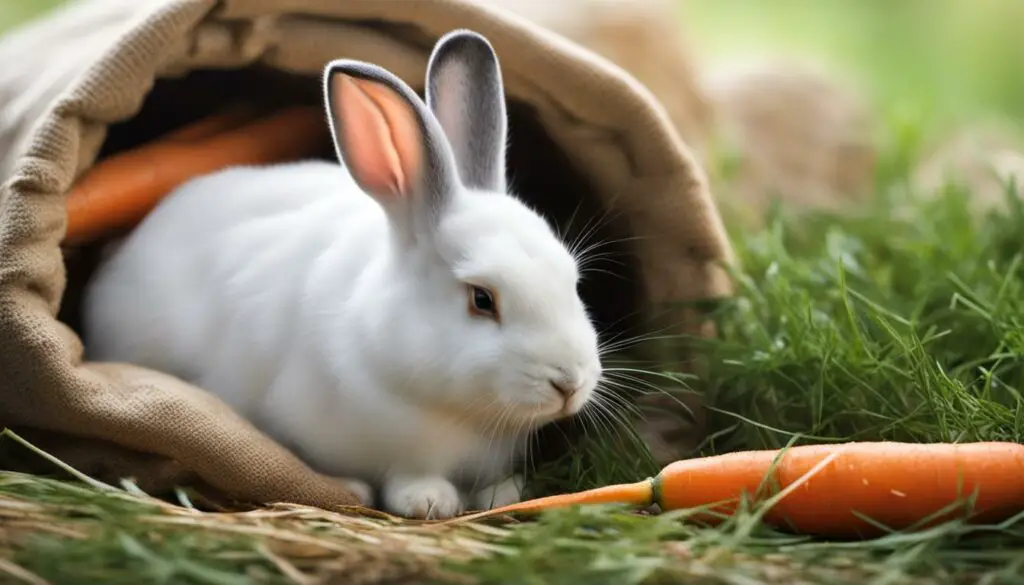
How Does Temperature Affect Rabbit Sleep?
Temperature plays a significant role in a rabbit’s sleep patterns and behavior. Bunnies are sensitive to their environment, and temperature fluctuations can impact their sleep quality and comfort. This section explores how hot and cold temperatures affect rabbit sleep and what you can do to ensure your bunny’s well-being.
Hot Temperatures
In hot weather, rabbits may struggle to regulate their body temperature effectively. They are more likely to sprawl out or flop over against a cool surface to cool down. This behavior helps them dissipate heat and avoid overheating. Providing your bunny with a shaded area, such as under a tree or an umbrella, can help them find relief from the heat.
It’s crucial to ensure that your rabbit has access to fresh water at all times, especially during hot temperatures. Water helps them stay hydrated and maintain optimal body temperature. Additionally, you can place ceramic tiles or cooling mats in their enclosure for them to lie on, as these surfaces stay cool and provide comfort.
Cold Temperatures
During cold weather, rabbits may tuck into a loaf position to conserve body heat and stay warm. They may hunker down and tuck their paws underneath their bodies to minimize exposure to the cold. Providing cozy bedding materials, such as straw or fleece, can help insulate their sleeping area and keep them warm.
It’s crucial to protect rabbits from severe cold temperatures, as they are susceptible to hypothermia. Ensure their enclosure is insulated and draft-free, and consider using heat lamps or heated pads to provide additional warmth. However, be cautious with heat sources and ensure they are placed safely to prevent any accidents or burns.
Summary
Temperature significantly affects how rabbits sleep and behave. In hot temperatures, rabbits may sprawl out or flop over to cool down, while in cold temperatures, they may tuck into a loaf position to stay warm. It’s essential to provide a suitable environment for your bunny by offering shady areas and access to fresh water in hot weather and providing warm bedding and insulation in cold weather. By considering temperature and creating a comfortable sleep environment, you can help your rabbit get the rest they need for optimal health and well-being.
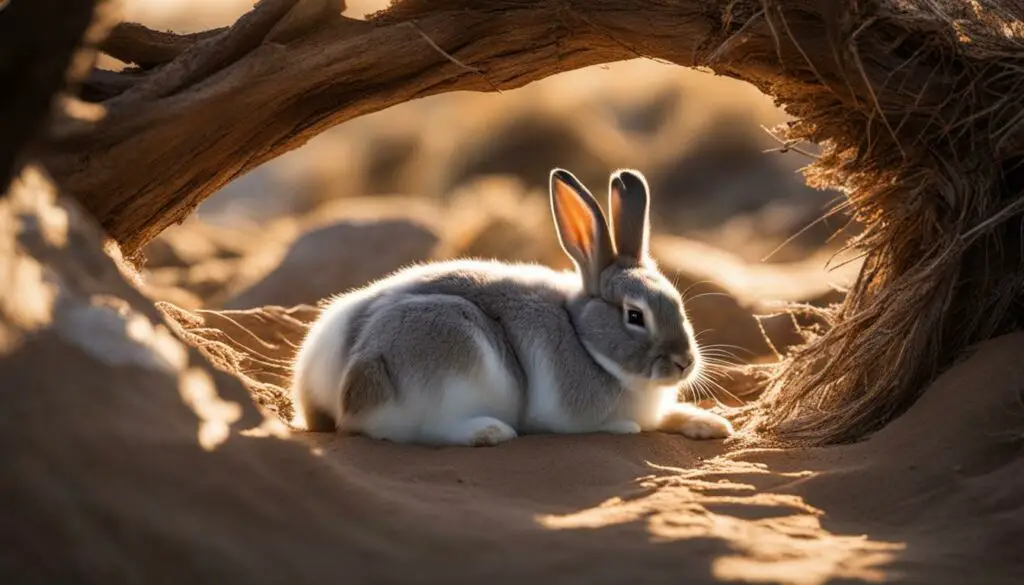
Providing the Right Sleep Environment for Your Rabbit
Creating a suitable sleep environment for your rabbit is crucial for their well-being and quality sleep. While rabbits do not necessarily require complete darkness to sleep, it is best to provide them with a room that receives some natural light, following their natural sleep patterns. Avoid using a night light or excessive artificial lighting, as this can disrupt their sleep cycles.
Rabbits should have a safe and quiet sleeping area, free from disturbances. This can be achieved by providing them with a suitable enclosure that includes hiding spots where they can feel secure. Additionally, opt for comfortable bedding that promotes restful sleep. Soft materials, such as hay or fleece, can provide a cozy and comforting sleeping surface for your rabbit.
When setting up the sleep environment, consider the temperature. Rabbits are sensitive to extreme temperatures, so ensure that the room is kept at a comfortable level. In hotter temperatures, rabbits may be more likely to sprawl out or flop against a cool surface to regulate their body temperature. In colder temperatures, they may prefer to tuck into a loaf position to conserve heat and stay warm.
To summarize, providing the right sleep environment for your rabbit involves:
- Ensuring the room receives some natural light, avoiding excessive artificial lighting
- Creating a safe and quiet sleeping area with hiding spots
- Using comfortable bedding materials, such as hay or fleece
- Maintaining a comfortable temperature in the room
By following these guidelines, you can help your rabbit get the rest they need for optimal health and well-being.

Recognizing When Your Rabbit Is Sleeping
It can sometimes be tricky to determine whether or not a rabbit is sleeping. Unlike humans, rabbits can sleep with their eyes open, and they often sit in the same positions they sleep. However, there are a few subtle signs that can help you recognize when your rabbit is catching some z’s.
One indicator is a decrease in nose twitching. Rabbits have a natural habit of twitching their noses, which helps them gather information about their environment. When they’re in a deep sleep, their nose twitching slows down or may even stop momentarily.
Another clue is relaxed body posture. When rabbits are asleep, their bodies tend to be more limp and loose compared to when they’re awake and alert. Their muscles are more relaxed, and they may appear less tense overall.
In addition, a sleeping rabbit may be less responsive to external stimuli. They may not react as quickly to sounds or movements around them. This doesn’t necessarily mean they’re in a deep sleep, as rabbits can quickly snap out of sleep and become alert if they sense any potential danger.
Table: Sleep Indicators in Rabbits
| Sleep Indicator | Description |
|---|---|
| Decreased nose twitching | Nose twitching slows down or stops during sleep. |
| Relaxed body posture | Rabbit’s body appears more limp and loose while sleeping. |
| Decreased responsiveness | Rabbit may be less reactive to external stimuli like sounds or movements. |
Observing your rabbit’s behavior over time will also help you understand their sleep patterns better. Each rabbit is unique, and they may have slight variations in their sleep habits. By paying attention to their body language and subtle signs, you can develop a better understanding of when your bunny is catching some much-needed shut-eye.
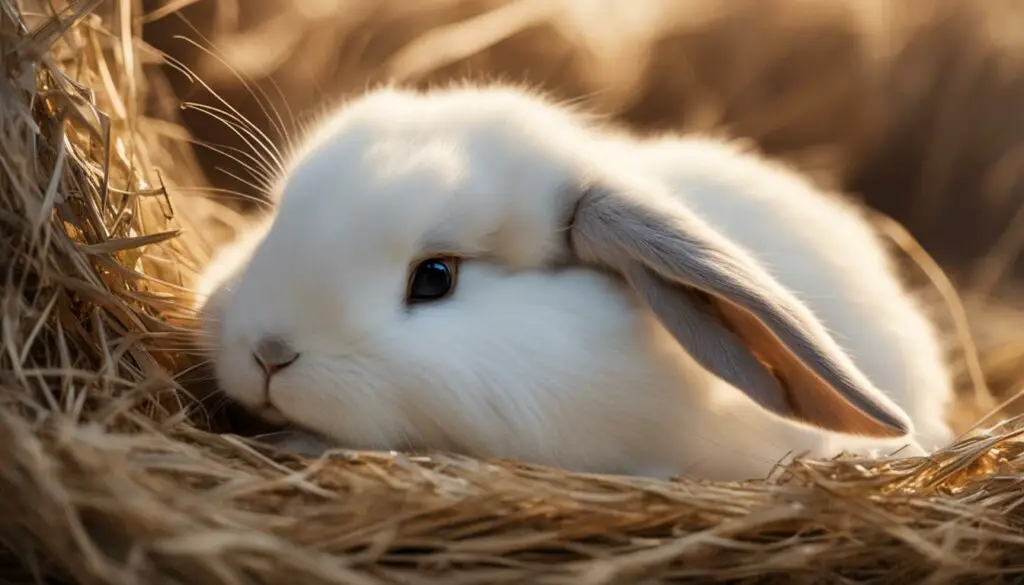
Unique Sleep Habits of Sleeping Bunnies
When it comes to sleep, bunnies can exhibit some unique habits that set them apart from other animals. One fascinating behavior is the occurrence of atonic and myoclonic movement during sleep. These movements can manifest as jerking or twitching while the rabbit is in a deep slumber. It’s important to note that these movements are completely normal and should not be a cause for concern.
Another interesting behavior that rabbits may display while sleeping is grinding their teeth. This rhythmic grinding is often a sign of contentment and relaxation. So, if you notice your bunny grinding their teeth during sleep, it’s a good indication that they are feeling happy and comfortable in their sleep environment.
It’s essential to let sleeping bunnies rest undisturbed, as they can become grumpy if awakened abruptly. When a rabbit is in a deep sleep, they may not respond immediately to external stimuli. It’s crucial to respect their need for uninterrupted sleep and provide them with a safe and comfortable sleep environment.
“Rabbits have their own unique sleep habits, including atonic and myoclonic movements during sleep and tooth grinding, which indicates contentment. Respecting their need for uninterrupted sleep is important for their overall well-being.” – Bunny Sleep Expert
| Sleep Habit | Explanation |
|---|---|
| Atonic and Myoclonic Movements | Jerking or twitching movements during deep sleep, can be completely normal. |
| Teeth Grinding | Signifies contentment and relaxation during sleep. |
Understanding and appreciating these unique sleep habits of bunnies can help us create a sleep-friendly environment for our furry friends. By providing them with a tranquil and comfortable space, we can ensure that they get the quality rest they need to thrive both physically and mentally.
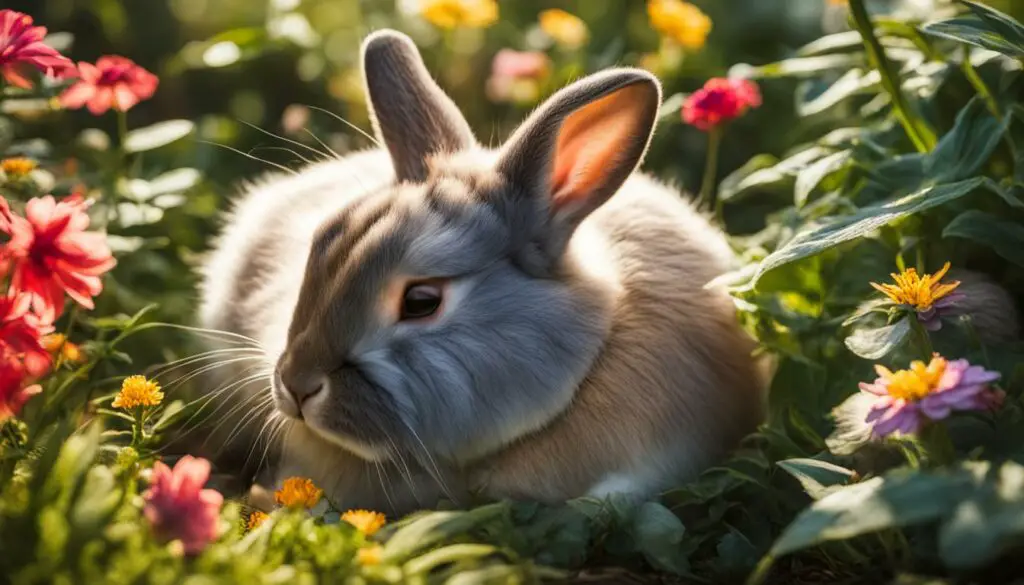
Next, we’ll explore the sleeping habits of wild rabbits versus pet rabbits, shedding light on the differences in their sleep patterns and behaviors.
Sleeping Habits of Wild Rabbits vs. Pet Rabbits
Wild rabbits and pet rabbits may have some differences in their sleeping habits due to their living environments and levels of security. Here’s a comparison of the sleeping habits of wild rabbits and pet rabbits:
Wild Rabbits
In the wild, rabbits are constantly on high alert for predators, which affects their sleep patterns. They are most active during the dim light hours of dawn and dusk, known as crepuscular activity. To protect themselves, wild rabbits often sleep with their eyes open, enabling them to remain alert to potential threats even while resting. This constant vigilance allows them to react quickly and escape danger.
Wild rabbits also have the ability to take short naps interspersed with active periods during the day. This allows them to conserve energy while still being able to forage for food and engage in other necessary activities. Their sleep cycles may vary depending on factors such as the availability of food, the presence of predators, and the changing seasons.
Pet Rabbits
Pet rabbits, on the other hand, generally have a more secure and comfortable living environment. They are less exposed to predators and have a consistent source of food and shelter. As a result, pet rabbits may feel safer and more at ease, allowing them to fully close their eyes or partially close them while sleeping.
The sleeping patterns of pet rabbits typically align with their wild counterparts, with a preference for crepuscular activity. They may be most active during the evening and early morning, and their sleep is often fragmented with short naps throughout the day. However, pet rabbits may have more flexibility in their sleep patterns depending on their individual personalities and the routines established by their owners.
Overall, while the sleeping habits of wild rabbits and pet rabbits may have some differences, both types of rabbits prioritize their safety and well-being during their sleep, whether it’s by remaining alert or finding comfort in a secure environment.
| Wild Rabbits | Pet Rabbits |
|---|---|
| Sleep with eyes open to stay alert | May fully or partially close their eyes |
| Most active during dawn and dusk | Typically active in the evening and early morning |
| Short naps interspersed with active periods | Fragmented sleep with short naps throughout the day |
| Constant vigilance for predators | Safe and secure living environment |
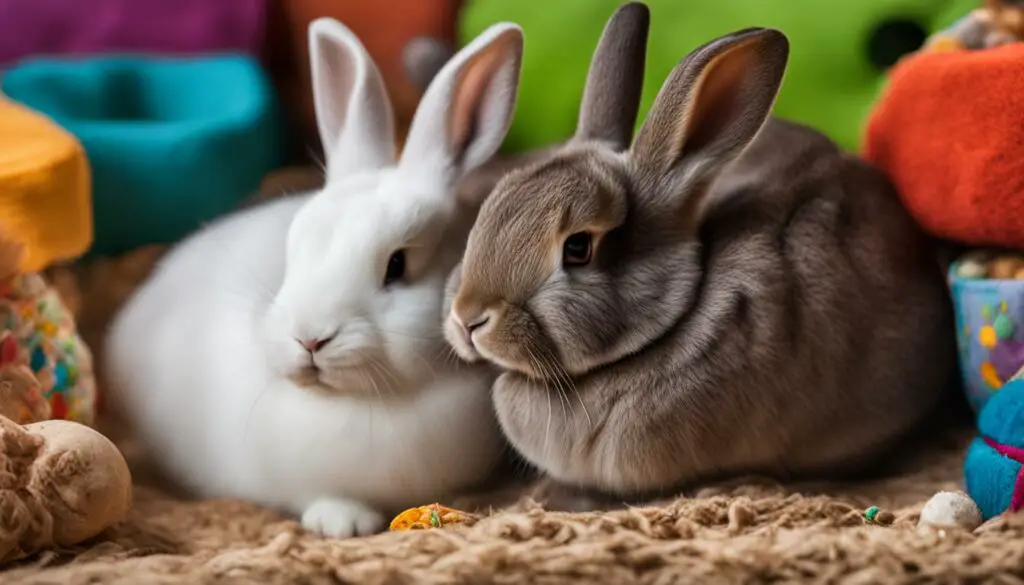
Key Differences in Sleeping Habits
- Wild rabbits sleep with their eyes open, while pet rabbits may fully or partially close their eyes.
- Wild rabbits are most active during dawn and dusk, while pet rabbits are typically active in the evening and early morning.
- Wild rabbits take short naps interspersed with active periods, while pet rabbits have fragmented sleep with short naps throughout the day.
- Wild rabbits prioritize constant vigilance for predators, while pet rabbits enjoy a safe and secure living environment.
Understanding the sleeping habits of both wild and pet rabbits can help rabbit owners create a suitable sleep environment that promotes comfort and well-being.
Importance of a Safe and Comfortable Sleep Environment
Creating a safe and comfortable sleep environment for your rabbit is vital for their overall well-being and quality of sleep. Rabbits have specific sleep patterns and habits that can be influenced by their surroundings. By providing the right conditions, you can help ensure that your bunny gets the rest they need to stay healthy and happy.
The Role of Safety
Rabbits are prey animals, and as such, they have a natural instinct to be cautious and alert to potential dangers. To help your rabbit feel safe while sleeping, it’s important to provide them with a proper enclosure that offers hiding spots where they can retreat if they feel threatened. This could include tunnels, boxes, or even purpose-built hideouts. Creating a secure environment helps to reduce stress and promotes a more restful sleep for your furry friend.
Comfort is Key
In addition to safety, comfort is also essential for a good night’s sleep. Rabbits need a soft and comfortable bedding material to snuggle into. Options such as hay, straw, or shredded paper can provide a cozy and warm sleeping surface. It’s important to regularly clean and replace the bedding to maintain cleanliness and hygiene.
Regulating the temperature in your rabbit’s sleep environment is also crucial. Extreme heat or cold can disrupt their sleep patterns and compromise their well-being. It’s best to keep their sleeping area in a cool and well-ventilated space, away from direct sunlight and drafts.
Minimizing Disturbances
Rabbits are sensitive to noise and sudden disturbances, which can interrupt their sleep. It’s important to provide a quiet environment during their designated sleep times. This includes avoiding loud noises, such as vacuuming or banging doors, near their sleeping area. If you have other pets, make sure they understand not to disturb your rabbit when they are resting.
By creating an environment that prioritizes safety, comfort, and minimal disruptions, you can help your rabbit establish healthy sleep patterns. Providing a safe and comfortable sleep environment is an important part of caring for your bunny and ensuring their overall well-being.

Bunny Sleep and Humans
Understanding the sleep patterns of rabbits is crucial for ensuring their well-being and creating a harmonious environment. While rabbits are crepuscular animals, meaning they are most active during the dawn and dusk hours, their sleep schedules may not always align with ours. It’s important to respect their natural rhythms and avoid disturbing them during their resting times.
Interacting with your rabbit during their alert and active periods, which are typically in the morning and evening, can be beneficial for both bonding and playtime. Avoid handling or engaging with your rabbit when they are resting or sleeping, as this can cause stress and may disrupt their sleep patterns.
Creating a sleep-friendly space for your rabbit is also essential. Provide a quiet and secure environment with comfortable bedding and minimal disturbances. Avoid placing your rabbit’s sleeping area near sources of noise or excessive light. While rabbits don’t necessarily need complete darkness to sleep, it’s best to provide a room with natural light that aligns with their natural sleep patterns.
Remember, a well-rested rabbit is a happy rabbit. By respecting their sleep needs and providing a conducive sleep environment, you can help ensure that your bunny gets the rest they need for optimal health and well-being.
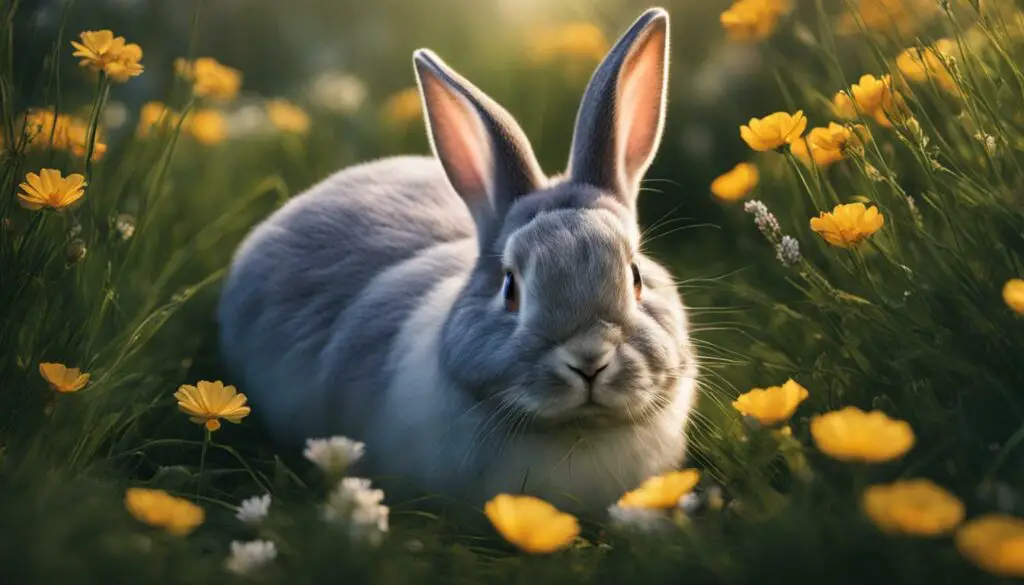
Promoting Healthy Rabbit Sleep Patterns
Here are some additional tips for promoting healthy sleep patterns in your rabbit:
- Establish a consistent daily routine for feeding, playtime, and rest.
- Provide ample opportunities for exercise and mental stimulation during your rabbit’s active periods.
- Avoid sudden disruptions or loud noises that may startle your rabbit during sleep.
- Monitor the temperature in your rabbit’s environment to ensure it is within a comfortable range.
- Observe your rabbit’s sleep behaviors and adjust their sleeping area or bedding if necessary.
By following these guidelines and understanding your rabbit’s unique sleep patterns, you can help promote a healthy and restful sleep routine for your furry friend.
Tips for Promoting Healthy Rabbit Sleep Patterns
Ensuring your rabbit gets sufficient sleep is essential for their overall health and well-being. By following these tips, you can help promote healthy sleep patterns for your furry friend:
1. Provide a Comfortable Sleep Environment
Rabbits need a safe and comfortable place to sleep. Make sure their sleeping area is quiet and free from any potential disturbances. Use soft bedding material, such as hay or fleece, to create a cozy sleeping spot. Additionally, consider providing a hiding spot or enclosure where your rabbit can retreat to when they want to rest.
2. Establish a Consistent Routine
Rabbits thrive on routine, so it’s important to establish a consistent daily schedule. Set regular feeding times and stick to them as closely as possible. This helps your rabbit feel secure and reinforces their natural sleep-wake cycle. Avoid sudden changes to their routine, which can disrupt their sleep patterns.
3. Encourage Exercise and Mental Stimulation
Regular exercise and mental stimulation during your rabbit’s active periods can help tire them out and promote better sleep. Provide them with toys, tunnels, and interactive games to keep them mentally and physically engaged. A tired rabbit is more likely to have a restful sleep.
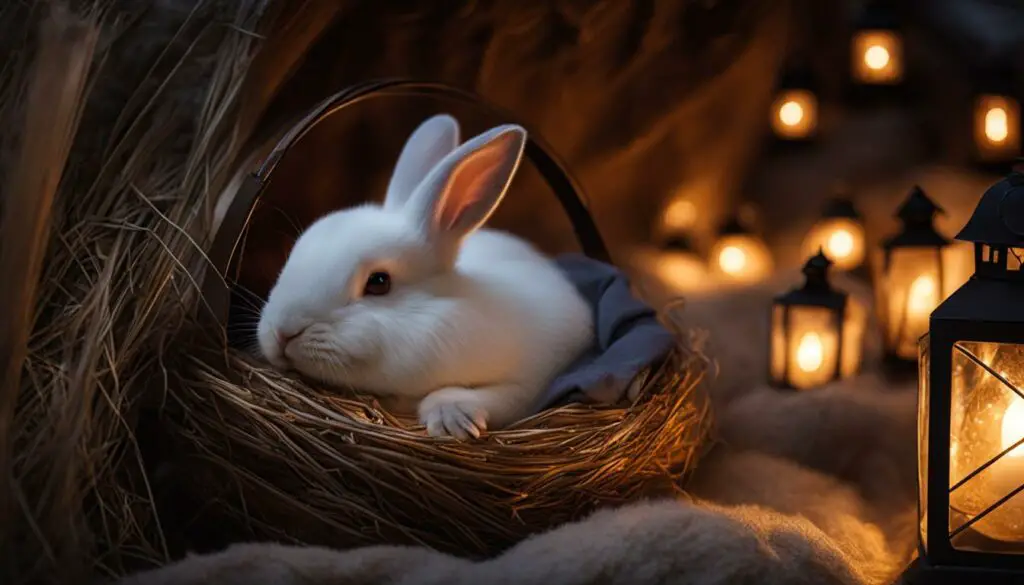
4. Create a Calm Sleeping Environment
Rabbits are sensitive to their surroundings, so it’s important to create a calm and peaceful sleeping environment. Avoid loud noises, bright lights, and sudden disruptions that can startle your rabbit during sleep. Keep their sleeping area separate from high-traffic areas to minimize disturbances.
By implementing these tips, you can help your rabbit establish healthy sleep patterns and ensure they get the rest they need for optimal health and happiness.
Conclusion
Understanding the sleep patterns and habits of rabbits is essential for providing them with a conducive sleep environment. Rabbits are crepuscular animals, with sleep cycles that align with the dim light hours of dawn and dusk. They can sleep with their eyes open and have various sleep positions.
By respecting their natural sleep patterns and creating a safe and comfortable sleep environment, you can help your bunny get the rest they need for optimal health and well-being.
FAQ
When do bunnies sleep?
Bunnies have unique sleep patterns and often take many short naps throughout the day and night.
How much sleep do rabbits need?
On average, rabbits sleep for about eight and a half hours a day, but they may sleep up to 12 hours if they feel safe and comfortable.
Are rabbits nocturnal or diurnal?
Rabbits are crepuscular animals, which means they are most active during the dim light hours of dawn and dusk.
Do rabbits sleep with their eyes open?
Yes, rabbits can sleep with their eyes open, thanks to a thin, transparent membrane called the third eyelid.
What are the different rabbit sleeping positions?
Rabbits have three main sleeping positions: loafing, sprawling, and flopping, which may vary depending on their comfort and temperature.
How does temperature affect rabbit sleep?
In hot temperatures, rabbits may sprawl out or flop over against a cool surface, while in cold temperatures, they may tuck into a loaf position to conserve heat.
What kind of sleep environment do rabbits need?
Rabbits need a safe and quiet sleeping area with comfortable bedding and minimal disturbances.
How can you recognize when your rabbit is sleeping?
Look for a decrease in nose twitching, relaxed body posture, and a lack of responsiveness to external stimuli.
What are some unique sleep habits of sleeping bunnies?
Sleeping bunnies may display atonic and myoclonic movement, grind their teeth, and sleep in various positions.
Do wild rabbits sleep differently from pet rabbits?
Wild and pet rabbits follow similar sleep patterns, but pet rabbits may feel more secure and comfortable, leading them to close their eyes while sleeping.
Why is a safe and comfortable sleep environment important for rabbits?
A suitable sleep environment is crucial for a rabbit’s overall well-being, providing them with a place where they feel secure and can get quality sleep.
How does bunny sleep align with human schedules?
While rabbits may be most active during the evening, it’s important to respect their natural sleep patterns and avoid disturbing them during their resting times.
How can you promote healthy sleep patterns in rabbits?
Ensure they have a suitable sleep environment, a consistent daily routine, and opportunities for exercise and mental stimulation during their active periods.
Is there a conclusion to understanding bunny sleep?
Understanding the sleep patterns and habits of rabbits is essential for providing them with a conducive sleep environment. By respecting their natural sleep patterns and creating a safe and comfortable sleep environment, you can help your bunny get the rest they need for optimal health and well-being.

